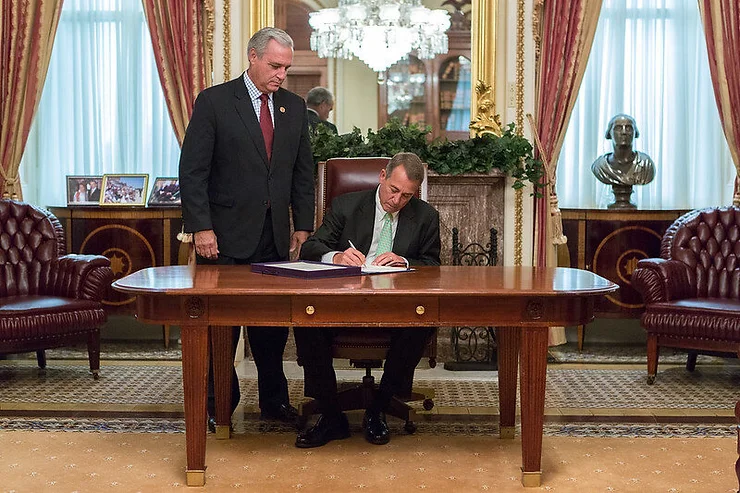With House Veterans’ Affairs Chairman Jeff Miller (R-FL) looking on, Speaker Boehner signs H.R. 3230, the Veterans’ Access to Care through Choice, Accountability, & Transportation Act. August 1, 2014. (Photo by Heather Reed)
HOW THE VA CAN BETTER MANAGE ITS RELATIONSHIPS WITH LEGISLATORS AND DRIVE BETTER CARE FOR VETERANS.
Since 2014, there has been a rapid transformation in the politics of veterans’ healthcare. The Veterans Healthcare Policy Institute spoke with Stephen Trynosky, author of Beyond the Iron Triangle: Implications for the Veterans Health Administration in an Uncertain Policy Environment.
Trynosky originally wrote the piece while serving at the Veterans Health Administration in 2014. He was also completing a Masters Degree at the School of Advanced Military Studies, United States Army Command and General Staff College. Beyond the Iron Triangle — his masters thesis — examines the deteriorating relationship inside the ‘Iron Triangle’ – the insular policy sphere made up of the Department of Veterans Affairs, Congressional Veterans’ Affairs Committees, and the big legacy Veteran Service Organizations.
This two part conversation covers how the relationships within the Triangle frayed during the 2014 waitlist crisis, how politicians used the power dynamics to push forward their own agendas, and how current policy making environment can be changed so that the VA can serve veterans’ needs.
The conversation has been lightly edited for length and clarity.
A Political Backwater: The House Committee on Veterans’ Affairs
Suzanne Gordon, VHPI Senior Policy Analyst: According to your past analysis, the U.S. House of Representatives’ Committee on Veterans Affairs hasn’t really been a committee of choice for many lawmakers. It’s composition doesn’t represent either the country or a broad political spectrum. Could you talk about that?
Stephen Trynosky: The House Veterans Affairs Committee (HVAC) is considered a very low prestige committee assignment within the House of Representatives. It is not a position that is viewed as an attractive perch for most members.
Historically, HVAC membership actually came with a fundraising penalty where it was seen as such a backwater, such a closed insular committee, that it was detrimental to its members’ ability to raise campaign funds and various donations. And for those variety of reasons, it has historically been a committee heavily stocked with junior, very green, new members in their initial term or two in the House. And, it is the type of committee where one looks to leave almost as soon as they can build up adequate seniority to get on to a more prestigious committee.
That has certainly been demonstrated in recent years. The MISSION Act was passed in 2018 – the sweeping MISSION Act – I believe that at the start of the current Congress, which started in January of 2019, the majority of the HVAC committee panel had not even been on the committee for the passage of the MISSION Act less than a year before.
It’s a tremendous churn, a tremendous amount of brain drain, and, as Rep. Jim Cooper (TN-05) has said, he calls the members of HVAC “green” and “inattentive.” And he made a comment that has been quoted saying “they don’t really understand VA or how the system works”, and by the time they have some familiarity, they move on to greener pastures so to speak, and the cycle continues.
So the relationship between the Department of Veterans Affairs (VA) and its House authorizing committee is very unique and very different from the experience that other cabinet-level agencies have with their authorizing committee on the Hill.
The relationship, for example, between the Department of Defense and the Armed Services committee – a more prestigious committee assignment, the members serve for a very long time, the staff are incredibly long-serving – and it’s that type of relationship. Ditto for the House Energy and Commerce committee which oversees pretty much all of Health and Human Services (HHS), other than the healthcare financing piece. Same concept. Once a member gets on, they stay on it, and they persist with it through the course of their career. This is certainly the case with Education, Labor, Appropriations, and so on.
So VA is caught in a bind because the committee that authorizes its existence and conducts oversight does not have that type of institutional knowledge, expertise, or commitment for the long term of staying engaged on VA issues and becoming experts.
Brett W. Copeland, VHPI Executive Director: When the MISSION Act was being debated, do you think privatization efforts were able to secure a stronghold within the VA committee simply because of that inattention? Like privatization test-runs for other agencies?
Trynosky: I think absolutely. I think, even hypothetically, even if a Member of Congress had never served in the military themselves, but by serving four, or five, or six terms on the House Armed Services Committee, they become very invested in the issues they care about. They have a stake in them. They are much more engaged in those type of discussions about what the second and third affects would be [of legislation]. That’s just a level of discourse that you generally don’t see on the HVAC.
I think also, a very important point to consider, is the ideological composition of the HVAC. That’s a very interesting thing to look at, because it truly does not reflect the ideological breadth of Congress as a whole, and more specifically, the Democratic Caucus.
If you look at the composition of the committee, it certainly on the Democratic side comes from the more centrist, in some cases, economically-conservative wing of the party. And there’s a number of metrics you can look at. The percentage of HVAC Democrats who are members of the Congressional Progressive Caucus, you could also look at in the current Congress, the really outsized representation of Democrats who went on the record in January 2019 and cast a vote publicly against Speaker Pelosi remaining the Speaker of the House.
That signals a little bit of what the composition is. The members of Congress who would potentially be the strongest advocates of a robust government-owned, government-operated VA system are noticeably absent, in large part, on that committee.
The Old Days of Bipartisanship
Gordon: What I find interesting is that groups like VoteVets and so forth, they are constantly recruiting progessive-ish candidates who are veterans. But then they don’t serve on the HVAC committee.
Trynosky: There’s a self selection bias. If candidates have a compelling personal brand, high earned media, and ambitions, especially – the HVAC is not a place they would seek out. They would want to immediately go into a higher level place, where potentially they would start out on Armed Services, Financial Services, or Oversight and Government Reform which have a little more of a cache for a first termer. Leadership also wants to make sure that their high potential, rising stars are on panels that raise their visibility.
I think one of the trends that you see – somewhat on the Republican side, but I think more on the Democratic side – is the types of members that self-select toward serving on the HVAC and the Homeland Security Committee, too. Both of these committees have this dynamic. It is where, even though they’re low prestige they’re somewhat sought by vulnerable members in swing districts that have a marginal partisan vote index one way or the other.
And so, new Members from swing districts work on the HVAC, as on Homeland Security. I think the conventional wisdom was that these committees were seen as places to demonstrate working across the aisle. Committees where there was, perhaps, not rabid partisanship and it would be, historically, a way for a Democrat in a marginally Republican district or vice versa to demonstrate to the voters that they were solutions-oriented and willing to work across the aisle.
So if a new member is coming from a very heavily Democratic safe district, that incentive doesn’t really exist to work on the HVAC and show that type of appearance of bipartisanship and so it wouldn’t be sought out. Also, the leadership has a role in this.
If the leadership identifies someone coming in who is photogenic and has a compelling biography, they’re going to want to put them on a committee where they are going to be able to fundraise and have a platform to garner media attention, build their brand, and their influence within the House.
Chairman Miller Brings 21st Century-Style Total Political Warfare to Veterans’ Issues
Copeland: Do you think that Rep. Jeff Miller, former Chairman of the HVAC took what you described and ran with it in ways that former chairmen had not?
Trynosky: Absolutely. Jeff Miller had an incredibly sophisticated understanding of the ecosystem of national veterans policy and had a very sophisticated understanding of the potential opportunities to establish a visible role as a chairman. I think that was clearly evident in his ability to really draw attention to HVAC’s investigations and oversight activities.
If you look up 2013 and early 2014 before the Phoenix scandal, I believe that he was able to get two weekly Republican Addresses focused narrowly on VA oversight issues– one for himself and one for Rep. Jackie Walorski from Indiana. These were essentially the weekly Saturday rebuttal speeches to President Barack Obama’s weekly address.
He was able to very strategically use issues of high political saliency to drive investigations. His press operation was first rate to be able to cultivate a network of nonpartisan investigative reporters from a variety of outlets and feed them stories and exclusives to amplify that attention.
All that stuff was just how things have worked on other committees for decades, or at least since Newt Gingrich’s Speakerships. That’s just the way other committees would do business. But it had never really come to the VA committee. So, Miller was really able to learn what other committee chairman had done, identify the opportunities to build attention and focus for the the HVAC. I like to say, he took the HVAC into the 21st century – for good or for ill. What he ushered in were trends that were already happening in other congressional committees and he basically brought many of those traits to discussion of veterans issues. I would also point out that he had a lucky break due to several structural realities within Congress.
At the time, the poorly funded Senate Veterans Affairs Committee (SVAC), unbelievably, did not have a full press operation. That has now been rectified, but at the time the SVAC and Chairman Sanders did not have a full time press secretary.
So the absence of any full time press/media operation on the SVAC just gave Chairman Miller an outsized platform because his press staff were the only game in town on Capitol Hill for reporters from any outlet. That became a source of “ground truth” for members and their staff in both chambers and on both sides of the aisle.
A growing bipartisan Congressional constituency bypassed VA itself because of suspicion or distrust. Instead, they went to Chairman Miller’s press operation and get information. So he had a very unique, very outsized influence and he exploited it.
A benchmark that shows the genius and the very sophisticated understanding that he had, was the House leadership’s support for his committee’s efforts. At the time, Congress was subjected to the sequester just like the Executive Branch. Despite the sequester, despite the committees having to take “haircuts”, the House leadership basically doubled the investigative staff of the HVAC with Mr. Miller as the chairman despite the sequester and it gave the HVAC an overall funding increase. It enabled them to take on an even more aggressive oversight posture and that seemed to make sense to the leadership and they saw that as an opportunity to amplify their message.


